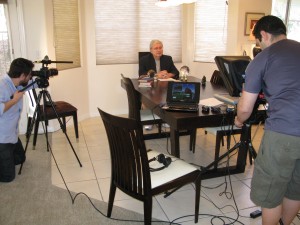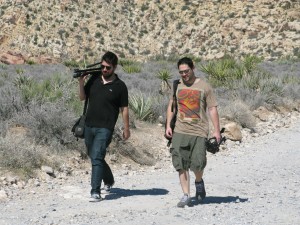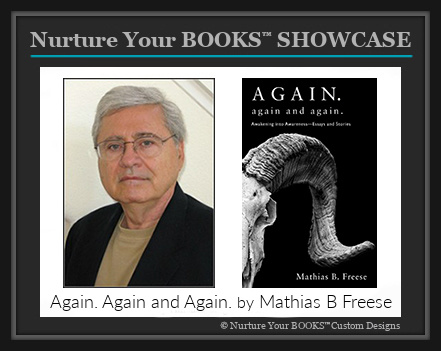 Last month I was fortunate to witness a movie being made by Jordan Freese, assisted by Brendan Jamieson and featuring my husband Matt. It took all day Saturday and most of Sunday to film (or rather digitally record) a teleplay that will probably end up running less than 15 minutes.
Last month I was fortunate to witness a movie being made by Jordan Freese, assisted by Brendan Jamieson and featuring my husband Matt. It took all day Saturday and most of Sunday to film (or rather digitally record) a teleplay that will probably end up running less than 15 minutes.
I now have a greater appreciation for all the preparation and time that is required to create something of quality. As with all movies, much of what was recorded will end up on the proverbial cutting room floor. As Jordan explained, “Even if you think you shot it perfectly, you never know. There could be a tiny glitch in the picture or audio and then you’re screwed if you don’t have a backup.” Dialogue and scenes must be recorded multiple times.
The film entitled “Non-fiction” is, from what I gather, an exploration of what is real and what is not real in film making and how the viewer viscerally responds to what is presented. Jordan is treading on treacherous ground in the sense that he creates a character, Old Ornery Prick (played by Matt), who both challenges and insults the viewer.
I asked Jordan about the premise and purpose of the film and I am still struggling with why he wants to confront his viewers in this way. Asking an artist why he or she does something is often folly since what the artist is trying to say can only be expressed through the work itself.
In another short film Jordan created in 2009 entitled “Casting,” he directs an audition. He placed an ad on Craigslist calling for actors to audition for a movie. The actors are not informed until later that the audition is the movie itself. No future movie is scheduled. There are uncomfortable moments as the actors struggle to make sense of a non-sensible script. The IMDb listing describes the film as: “A behind the scenes look at a casting call where the fine line between acting and reality blur.”
I asked Jordan if he is interested in confusion. “Dead Man,” “American Psycho,” and “Exit Through the Gift Shop” are some of the films he recommended Matt and I watch and they seem to challenge the audience’s preconceptions about traditional story structure and the questionable reliability of the protagonists. He explained later that it isn’t confusion that interests him so much as throwing the viewing experience off balance and making the viewer question his or her own expectations and emotional responses.
This hit home to me yesterday as I was driving and listening to Neal Boortz. I enjoy listening to conservative talk radio from time to time because the viewpoints expressed are antithetical to my opinion on the issues. We all have a tendency to seek out information that supports what we already believe. Maybe I enjoy being annoyed, but I try to keep an open mind. On this particular program Boortz stated emphatically that people who are undereducated and ill-informed tend to support Barak Obama. Over and over again he repeated in the most insulting way imaginable that Democrats are essentially stupid. I found myself getting angry and feeling insulted. Then I remembered that this is what Jordan is pointing out: Our illogical response to the media. It is absurd to allow someone who doesn’t know me to insult me.
In “Non-fiction,” Matt’s character, Old Ornery Prick, makes a point of looking straight into the camera and saying, “I’m insulting you specifically.” Of course, this is absurd. He can only insult the viewer if he or she allows it. Who is in control? If it is Old Ornery Prick, why does the viewer allow him that control? Why do any of us allow our feelings to be manipulated?
Though I had some understanding from my conversations with Jordan what he was going for, I must admit, while watching the monologue being recorded, I felt uneasy and at times insulted. Why is Old Ornery Prick calling the viewer repugnant, a moron, ugly, shitbag, etc.?
Brendan Jamieson, Jordan’s colleague and friend assisted in photographing “Non-fiction.” He articulated some of my concerns. He said in essence, there is a fine line between being provocative and simply annoying. This is the risk Jordan is taking and the fine line he is drawing.
Matt took to the project with gusto projecting the sarcasm and contempt that Jordan was looking for. He ceded control to the director like a pro. Using a teleprompter, Matt was able to look directly into the camera. The teleprompter is an ingenious tool of illusion used by politicians and news casters, allowing them to personalize their message as only the appearance of eye contact can accomplish. This is another example of what is unreal. Old Ornery Prick even states, “I’m trying to make this a bit interactive.” But how can the viewer possibly interact with pixels on a screen?
Being a child of the digital age, Jordan is exploring media intimacy in ways that would not occur to me. I come from a generation that grew up with movies and TV shows as a social activity. At least to me they are more enjoyable when shared with others. We are, after all, social animals. Perhaps we need others to reinforce how we are supposed to react. Laugh tracks indicate where the jokes are and when we are supposed to laugh. Sad music accompanies the hero’s death, just in case we aren’t sure how to feel.
Visual media, however, is something that more and more people are consuming alone on a laptop. Social media, in this case, is a contradiction. It is both personal and yet solitary. The internet is where “Non-fiction” will most likely air. How independent are our reactions? Ornery Old Prick asks, “Are you going to tell your friends about this later? Have them watch, just to see how they react and then know how you should have reacted instead?” Good question.
“Non-fiction” has no obvious agenda and offers no solutions. That is what makes it so fascinating and exasperating. I have no doubt that Jordan’s career as a film maker will be exciting to witness.
As a father and son collaboration, the filming of “Non-fiction” was a joy to watch. Matt wanted Jordan to use his skills to record his father and Jordan cast his Matt in a role where he could be the director and at the same time have his father be the star. This will be a warm and hilarious memory for everyone involved.
 Having these two delightful young men in our home for the weekend was the best part of the project. They are both at a time in their lives when the future is full of promise. They have the skills and means to pursue their art and do so with vigor. They are healthy, handsome, and free of encumbering dependents and mortgages. After filming at Red Rock Canyon Sunday, I confess to feeling a slight twinge of envy as a watched Jordan and Brendan walk back to the car with their camera gear, side by side in the sunlight.
Having these two delightful young men in our home for the weekend was the best part of the project. They are both at a time in their lives when the future is full of promise. They have the skills and means to pursue their art and do so with vigor. They are healthy, handsome, and free of encumbering dependents and mortgages. After filming at Red Rock Canyon Sunday, I confess to feeling a slight twinge of envy as a watched Jordan and Brendan walk back to the car with their camera gear, side by side in the sunlight.







Guest Blog by Jane Freese: A Fine Line
I now have a greater appreciation for all the preparation and time that is required to create something of quality. As with all movies, much of what was recorded will end up on the proverbial cutting room floor. As Jordan explained, “Even if you think you shot it perfectly, you never know. There could be a tiny glitch in the picture or audio and then you’re screwed if you don’t have a backup.” Dialogue and scenes must be recorded multiple times.
The film entitled “Non-fiction” is, from what I gather, an exploration of what is real and what is not real in film making and how the viewer viscerally responds to what is presented. Jordan is treading on treacherous ground in the sense that he creates a character, Old Ornery Prick (played by Matt), who both challenges and insults the viewer.
I asked Jordan about the premise and purpose of the film and I am still struggling with why he wants to confront his viewers in this way. Asking an artist why he or she does something is often folly since what the artist is trying to say can only be expressed through the work itself.
In another short film Jordan created in 2009 entitled “Casting,” he directs an audition. He placed an ad on Craigslist calling for actors to audition for a movie. The actors are not informed until later that the audition is the movie itself. No future movie is scheduled. There are uncomfortable moments as the actors struggle to make sense of a non-sensible script. The IMDb listing describes the film as: “A behind the scenes look at a casting call where the fine line between acting and reality blur.”
I asked Jordan if he is interested in confusion. “Dead Man,” “American Psycho,” and “Exit Through the Gift Shop” are some of the films he recommended Matt and I watch and they seem to challenge the audience’s preconceptions about traditional story structure and the questionable reliability of the protagonists. He explained later that it isn’t confusion that interests him so much as throwing the viewing experience off balance and making the viewer question his or her own expectations and emotional responses.
This hit home to me yesterday as I was driving and listening to Neal Boortz. I enjoy listening to conservative talk radio from time to time because the viewpoints expressed are antithetical to my opinion on the issues. We all have a tendency to seek out information that supports what we already believe. Maybe I enjoy being annoyed, but I try to keep an open mind. On this particular program Boortz stated emphatically that people who are undereducated and ill-informed tend to support Barak Obama. Over and over again he repeated in the most insulting way imaginable that Democrats are essentially stupid. I found myself getting angry and feeling insulted. Then I remembered that this is what Jordan is pointing out: Our illogical response to the media. It is absurd to allow someone who doesn’t know me to insult me.
In “Non-fiction,” Matt’s character, Old Ornery Prick, makes a point of looking straight into the camera and saying, “I’m insulting you specifically.” Of course, this is absurd. He can only insult the viewer if he or she allows it. Who is in control? If it is Old Ornery Prick, why does the viewer allow him that control? Why do any of us allow our feelings to be manipulated?
Though I had some understanding from my conversations with Jordan what he was going for, I must admit, while watching the monologue being recorded, I felt uneasy and at times insulted. Why is Old Ornery Prick calling the viewer repugnant, a moron, ugly, shitbag, etc.?
Brendan Jamieson, Jordan’s colleague and friend assisted in photographing “Non-fiction.” He articulated some of my concerns. He said in essence, there is a fine line between being provocative and simply annoying. This is the risk Jordan is taking and the fine line he is drawing.
Matt took to the project with gusto projecting the sarcasm and contempt that Jordan was looking for. He ceded control to the director like a pro. Using a teleprompter, Matt was able to look directly into the camera. The teleprompter is an ingenious tool of illusion used by politicians and news casters, allowing them to personalize their message as only the appearance of eye contact can accomplish. This is another example of what is unreal. Old Ornery Prick even states, “I’m trying to make this a bit interactive.” But how can the viewer possibly interact with pixels on a screen?
Being a child of the digital age, Jordan is exploring media intimacy in ways that would not occur to me. I come from a generation that grew up with movies and TV shows as a social activity. At least to me they are more enjoyable when shared with others. We are, after all, social animals. Perhaps we need others to reinforce how we are supposed to react. Laugh tracks indicate where the jokes are and when we are supposed to laugh. Sad music accompanies the hero’s death, just in case we aren’t sure how to feel.
Visual media, however, is something that more and more people are consuming alone on a laptop. Social media, in this case, is a contradiction. It is both personal and yet solitary. The internet is where “Non-fiction” will most likely air. How independent are our reactions? Ornery Old Prick asks, “Are you going to tell your friends about this later? Have them watch, just to see how they react and then know how you should have reacted instead?” Good question.
“Non-fiction” has no obvious agenda and offers no solutions. That is what makes it so fascinating and exasperating. I have no doubt that Jordan’s career as a film maker will be exciting to witness.
As a father and son collaboration, the filming of “Non-fiction” was a joy to watch. Matt wanted Jordan to use his skills to record his father and Jordan cast his Matt in a role where he could be the director and at the same time have his father be the star. This will be a warm and hilarious memory for everyone involved.